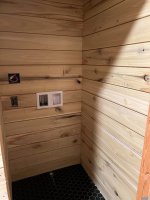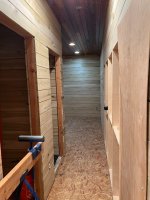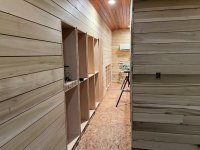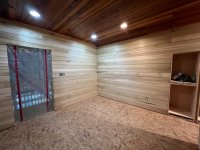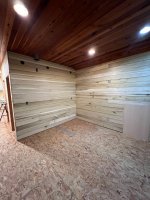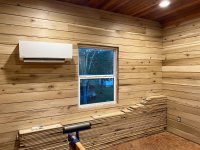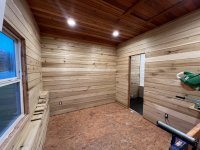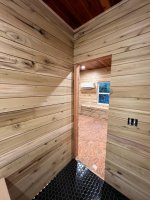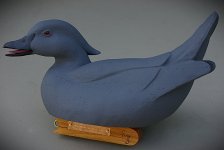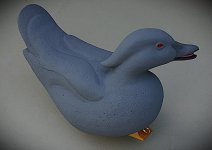I dabble in building fishing rods. Mostly for my own enjoyment, although I have both sold some finished rods and given some away. I don't have a dedicated build area and consequentially the rod blank, tools and building equipment, end up getting removed from the kitchen table, (so we can eat) several times until the rod is complete.
I built a 95" long base, to help consolidate some of the equipment clutter during these moves and it also serves to keep everything lined up and aligned during actual use.

The base needed to be flat, wide for stability, light in weight, yet stable from cupping warping or twisting.
I elected to use alternating strips of Black Ash and Poplar, cut from custom milled air dried lumber. The poplar boards were long enough to be used as is with the exception that all the wood was too thin. I cut all the 3/4 wood into strips that were 5/4. Then made a glue up that was 5/4 stock thickness. The Black Ash had many knots within and needed to be spliced with scarf joints, both to remove the knots and to gain increased length.
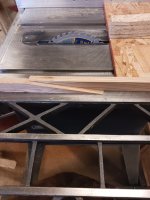
It took quite a few hours just to cut, glue and square up all the needed strips. The glue-up was accomplished one strip at a time until I had 1/2 of the final width.
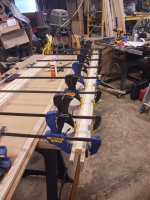
Doing so, allowed me to joint each 1/2 glue-up, flat and square again, before finally gluing the 2 halves together.
The final board came out flat, square and with out any twist. I ran the now 4/4 glue-up thru my thickness planner until I reached my desired thickness of 7/8". This thickness allows me to cut a 3/8" deep dado and retain 1/2" of solid board.
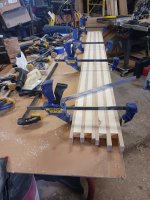
=========
I then put an 1/8" round over on all edges. The last cut was the dado cut right down the centerline, to accommodate full length (3 separate pieces) of "tee" track.

=========
Yes, the Poplar wood was quite riddled with worm tunnels.
Now, with the support stands, the motor stand and the wrapping station, all attached to the base board via the tee track, nothing falls off when I need to pickup and clear the kitchen table.
I built a 95" long base, to help consolidate some of the equipment clutter during these moves and it also serves to keep everything lined up and aligned during actual use.

The base needed to be flat, wide for stability, light in weight, yet stable from cupping warping or twisting.
I elected to use alternating strips of Black Ash and Poplar, cut from custom milled air dried lumber. The poplar boards were long enough to be used as is with the exception that all the wood was too thin. I cut all the 3/4 wood into strips that were 5/4. Then made a glue up that was 5/4 stock thickness. The Black Ash had many knots within and needed to be spliced with scarf joints, both to remove the knots and to gain increased length.

It took quite a few hours just to cut, glue and square up all the needed strips. The glue-up was accomplished one strip at a time until I had 1/2 of the final width.

Doing so, allowed me to joint each 1/2 glue-up, flat and square again, before finally gluing the 2 halves together.
The final board came out flat, square and with out any twist. I ran the now 4/4 glue-up thru my thickness planner until I reached my desired thickness of 7/8". This thickness allows me to cut a 3/8" deep dado and retain 1/2" of solid board.

=========
I then put an 1/8" round over on all edges. The last cut was the dado cut right down the centerline, to accommodate full length (3 separate pieces) of "tee" track.

=========
Yes, the Poplar wood was quite riddled with worm tunnels.
Now, with the support stands, the motor stand and the wrapping station, all attached to the base board via the tee track, nothing falls off when I need to pickup and clear the kitchen table.
Last edited:

